“Content is king” say the many marketers, sellers, and agency heads on LinkedIn. But what does that mean, and what is content, anyway?
It’s one of those vague, catchall words that means nothing and everything at the same time.
Content is the stuff we make, consume, and keep around. It dictates how we spend our time and even what we think about. It’s the videos we watch on TikTok and YouTube, it’s a new TV show or podcast episode, it’s the eBook you read, the data sheet you send to customers, the webinar you attended, and the sales presentations you create.

However you define it, one thing about content has become clear — too much of it paired with too little strategy and structure results in overwhelming chaos. In a sales enablement and wider business context, this chaos is costly and counterproductive.
To help you bring order to your content chaos, I sat down with Adrian La Sala, Senior Product Manager of Content Authoring & Learning Initiatives at Bigtincan, and Beverlie Heyman, our Director of Sales Enablement, to compile these best practices for creating and managing impactful sales enablement content.
TLDR: When it comes to content, less is more
Another phrase repeated recently, often, and loudly on LinkedIn and in corporate offices across the world, is “do more with less.” In the case of content, this holds true.
We’ve written before about the BIG HOT MESS (See: The cost of doing nothing — overcoming status quo bias in sales enablement). AKA the content clutter that occurs when subject matter experts spend their time creating content that never gets used or shared, so all their knowledge and the assets they created pile up in a disorganized and stale content graveyard.
The bigger the mess, the harder it is to clean up. And the harder it is for anyone to find what they’re looking for, often resulting in them simply giving up — meaning tons of lost work hours for content creators and valuable assets going unused.
Sellers, for example, might look at a 20-page catalog of content dating back to 2015 and assume there’s nothing of value in the mess — but the one win story hidden on page 9 could help them close their sale.
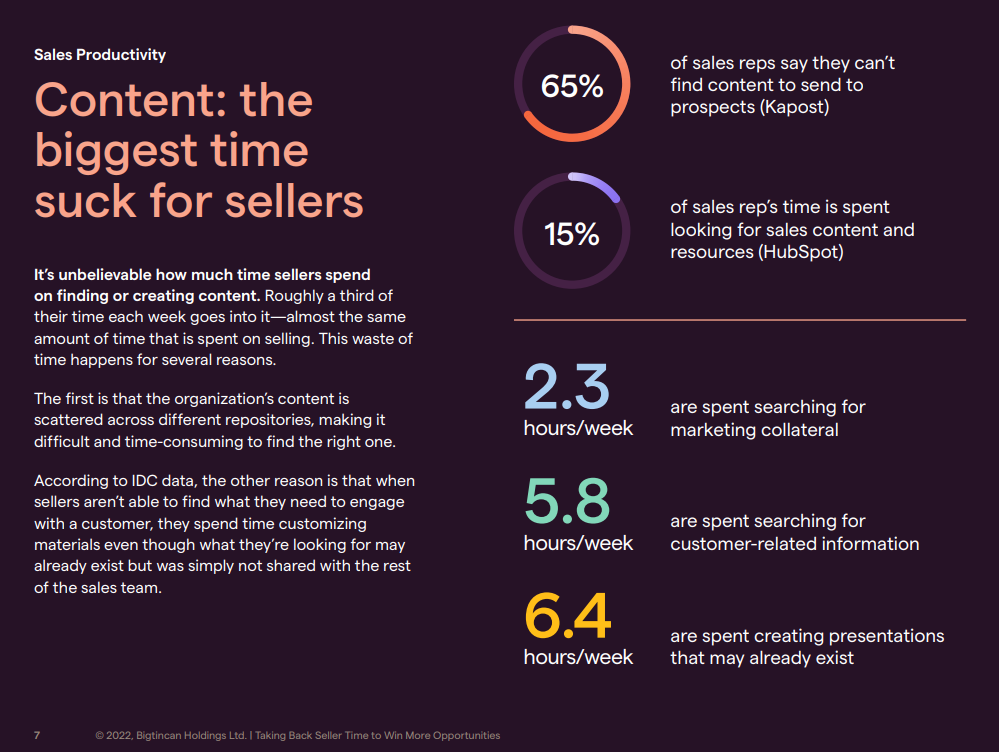
Get the full Sales Productivity eBook
So if you take anything away from this article, it should be this: Avoiding overwhelm is the number one, most important thing you can do to make your content make sense and have an impact on your audience — whether they’re customers, coworkers, students, or partners.
That means creating fewer pieces of content, updating what works, and deleting what doesn’t. Your catalog will be easier to search through and each piece will be more engaging. To achieve this, you need to be more tactful in deciding not only what content to create, but how you create it, and what you do with it in the long run.
What is sales enablement content?
In the interest of keeping it simple, let’s start with the basic definition of sales enablement content.
Sales enablement content is “content sales reps use to help them sell their products/services as they go through the sales process. It provides reps with support and answers to common questions, and it provides prospective customers with context and understanding in regards to a product” (Sales Enablement Collective).
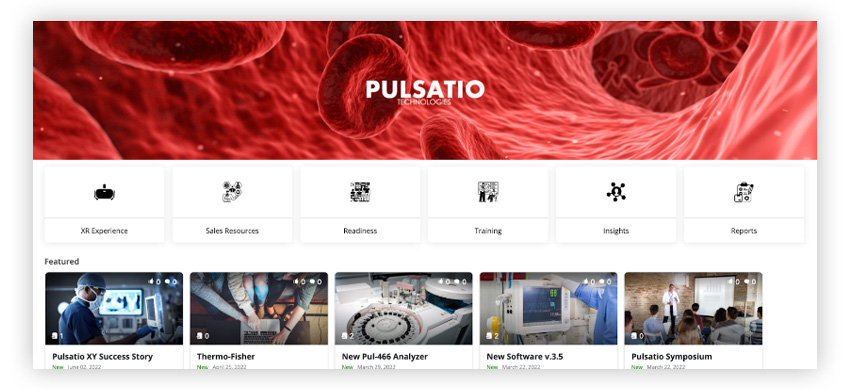
Bigtincan Content Hub branded for the faux company Pulsatio
As implied by that definition, there are two broad types of sales enablement content which cater to its two main audiences:
- Sales collateral – external, customer-facing content created by marketing and/or sales teams that educates and informs prospective customers in order to help them make a buying decision.
- Learning content – usually internal content created by subject matter experts (product team, product marketing, sales leaders, HR, etc.) or the sales enablement, training, or learning and development team — depending on your organization — to develop the skills and knowledge of team members or business partners.
Of course, beneath these two umbrellas sit several more types of content, or sub-categories, each of which has a different format and function. Read the next section for that breakdown.
How to create impactful sales collateral and learning content
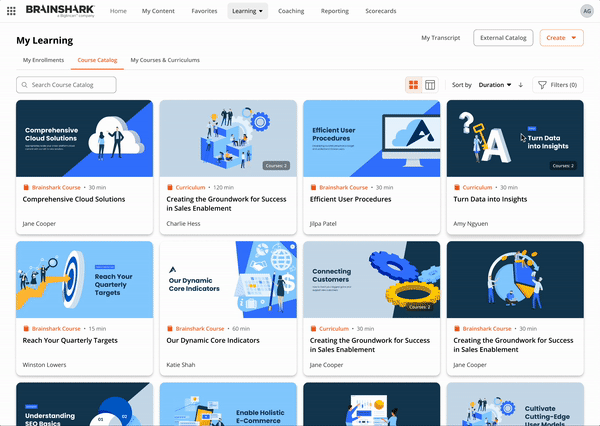
1. Content catalog
Let’s start with where your content lives — your content catalog.
“The biggest value enablement or learning leaders can bring to the table is culling, curation, and upkeep. Through those things will bring audience engagement, experience, adoption, and ROI,” said La Sala.
If you have a terse and tight catalog then each person using it can save 10-20 minutes every time looking for what they need. Multiply that 10 minutes x 1,000 employees and you have your ROI in company time saved spent searching for content — not to mention increased time spent on other tasks like selling or actually consuming the content and learning.
Further reading: Helping Sellers Become Buyer Ready — Implementing the right content strategy to enable marketing teams to do more with less and sales teams to become truly buyer centric.
Having a more tightly controlled and easily consumable catalog also tightens messaging across the board. An up-to-date and curated catalog means there won’t be data sheets from 2013 in the old branding and listing products or services that no longer exist.
Content catalog best practices:
- Decide what the best 1 course is per topic and keep that
- Decide what the best 1-3 customer stories are and keep those
- Track what is viewed and used and delete anything that hasn’t been opened in 6 months
- Routinely update high-performing content instead of scrapping it and creating something brand new each time.
- Put someone in charge of curating and managing the content catalog
Now let’s look at each type of content that may live in your content catalog and what to keep in mind when creating each one.
2. Long-form content
What is long-form sales enablement content? It’s an asset either your customers or your learners (employees, partners, etc.) are going to spend a long amount of time on. These days, anything that takes more than 15 minutes to consume can be considered long-form.
In the sales collateral category, long-form content usually includes eBooks, articles, podcast episodes, webinars, or even a demo or slide presentation.
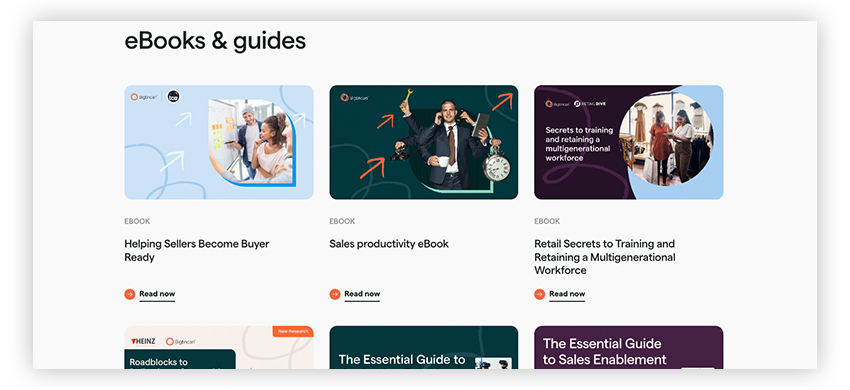
eBooks on the Bigtincan resources page
In the learning category, long-form content could be an in-person workshop, a one-hour virtual training session, or a three-hour orientation video.
Long-form content serves to thoroughly educate and inform audiences about a specific topic, such as content creation, or sales methodologies, or communication skills. It assumes the audience is invested enough in the topic to spend a longer amount of time reading or listening to it.
Long-form content best practices:
- Sell the value in the first minute (or the first paragraph or first page for written content). Any time someone is spending on your content is time they are spending not doing something else. (See: the attention economy.)
- Clearly label and organize the content so it is easy to come back to. If it’s a written asset, like an article or eBook, don’t assume it will be read in one sitting.
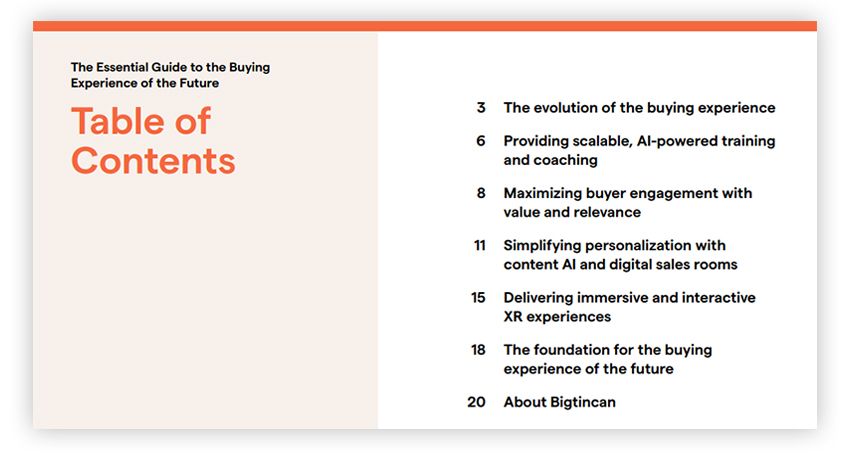 (See: The Essential Guide to the Buying Experience of the Future)
(See: The Essential Guide to the Buying Experience of the Future) - Summarize the main points for skimmers or those pressed for time.
- Avoid walls of text — break up written content with bullet points, visuals, shorter paragraphs, and whitespace.
- Keep audio/visual content interactive. Give the audience an activity related to the topic. For example, if you’re teaching social selling, have them look up their social selling index on LinkedIn. If you’re teaching how to use a workplace productivity or communication tool, such as Slack, have them share something with someone on there or use an add-on tool in real time to address issues and questions on the spot.
- Turn PowerPoints or presentations into dialogues instead of lectures.
- Avoid the “TV experience.” People are programmed to zone out to TV. If you absolutely MUST use a three-hour orientation video, break it up into sections and add interactive activities or quizzes to test knowledge retention.
3. Short-form content
Short-form sales enablement content is — you guessed it — sales or learning content that requires fewer than 15 minutes for the audience to consume.
Short-form sales collateral content usually includes shorter blog articles like listicles, product or “how-to” YouTube videos, datasheets, templates, or case studies.
Short-form learning content, also called “microlearning” or “just-in-time” learning, are usually short videos, recorded sessions, or narrated presentations, such as YouTube videos or Brainsharks, also called “Sharkbites.” Battlecards or other internal one-pagers such as cheat sheets or checklists are also included in this category.
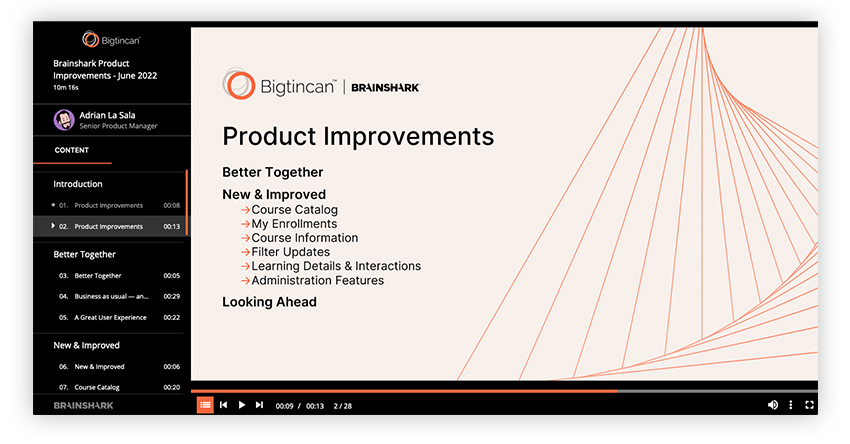
Short-form content best practices:
- Keep any videos, presentations, or recorded sessions under 15 minutes, preferably under 10.
- The screen should change at least once a minute.
- Slides should have minimal text and the narration should not just read the words on the slides verbatim, but elaborate on them.
- Even though these are short, refrain from uploading too many of these — only include just-in-time microlearning videos for the most common or important topics, such as brand or product messaging and the sales skills (e.g. objection handling) you know your reps need to quickly brush up on before meetings.
- Make any written content skimmable with bullet points, headers, bolding, and small blurbs.
- Include only essential information.
- Offer next steps for expanding on the topic or doing further research.
4. Micro-content
Micro-content is like short-form content but even shorter. “These are even less than a bite — an aperitif if you will,” said La Sala.
Micro-content takes the form of TikTok videos, Tweets, LinkedIn, or other social posts, and videos between 0 and 2 minutes. Like this testimonial video from our client Digi International:
As sales collateral, micro-content can be a testimonial quote, a “teaser” video, a podcast or video snippet (like the above), an ad, a meme, a mini deck of just a few slides, or a social post.
With the rise in social selling and native social content, micro-content is the fastest growing type of sales content.
Done strategically, these could all be used for learning purposes, as well— if even just to teach social selling or how to leverage micro-content in customer interactions.
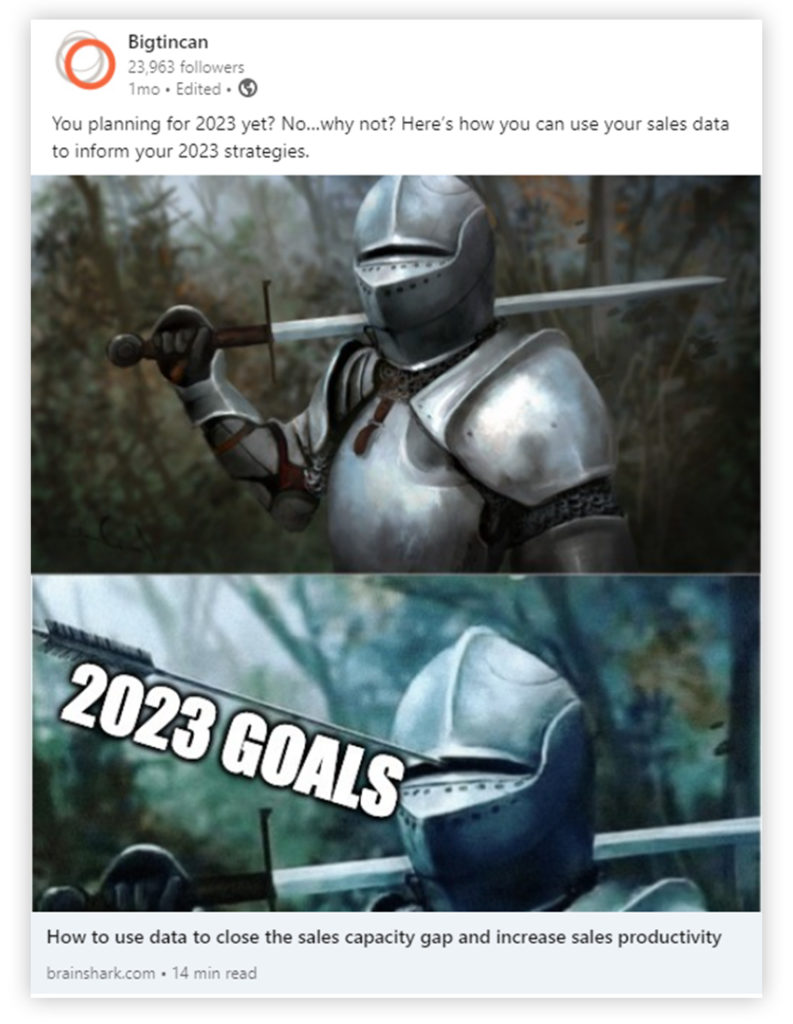
Micro-content best practices:
- Keep videos under 2 minutes or even as brief as 30 seconds.
- Repurpose videos as advertisements, social posts, or demo videos.
- Use these as lead-ins to more in-depth material, such as promoting a podcast by only sending out a one-minute snippet.
- Make sure the content fits this format — don’t cut anything too short if it deserves more air time, unless you are creating a series or course constructed of multiple pieces or doing what the previous bullet point describes.
- Know your audience! Not everyone will take kindly to being sent a meme or a 30-second TikTok in a business interaction.
5. Asynchronous content
Asynchronous content can be any length and is meant to be consumed any time, such as just-in-time learning, evergreen articles, or continuous training. As such, it is more of a sub-category of those already described, but worth its own mention since it is quickly becoming the most popular type of content due to the rise in remote work and learning.
Core content like brand guidelines, company policies, product information, or standard sales practices can take the form of asynchronous learning content.
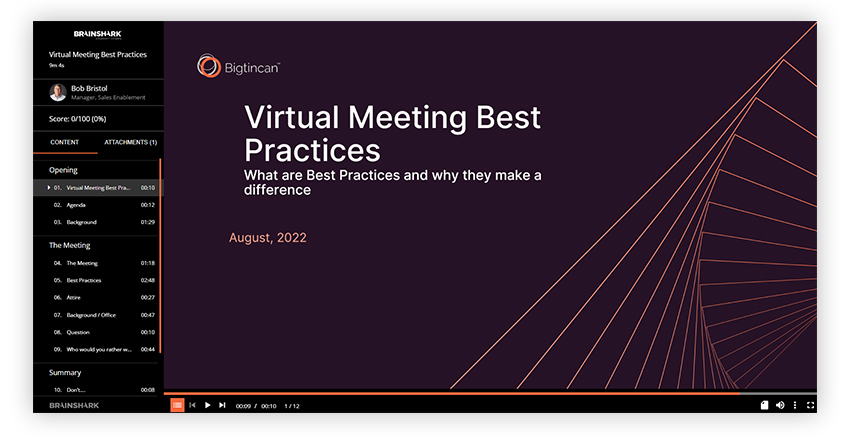
Where customers or sales collateral are concerned, asynchronous content is also meant to be consumed on the customer’s own time, like a datasheet, article, or video their rep sent them to peruse without any specific deadline.
It could also be interpreted as not funnel, stage, or journey-specific content, meaning it is not actively sent by the account rep and the customers can access it at any time, such as the company website, LinkedIn, or YouTube pages and anything they can download or interact with there.
Asynchronous content best practices:
- Update core content regularly so it is up to date and correct.
- Use content data and analytics to track which pieces of content are actually being consumed, whether viewers drop off at a certain point, whether the piece has been shared, and so on, so you can determine what core content is as well as what is gathering dust.
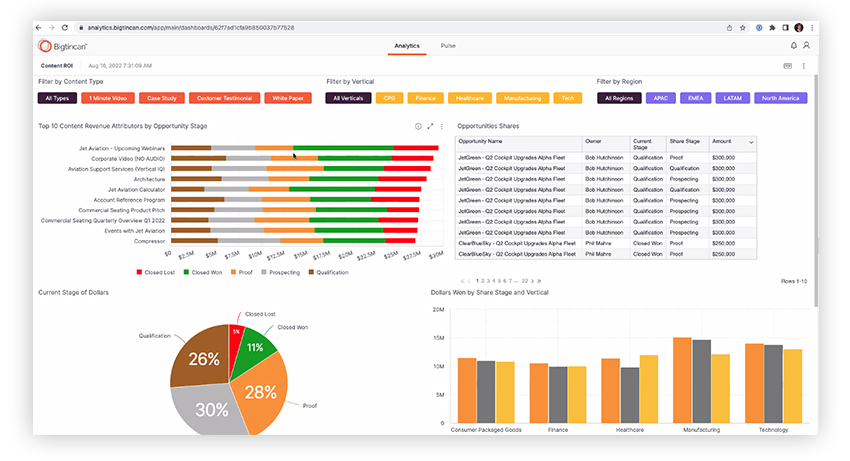
Bigtincan content analytics dashboard
- Any learning that is a recording or meant to be consumed on the learner’s own time, whether it is long or short-form, should have motion or changing of the screen every 30 seconds.
- If it’s a slide, then it should not be up there for more than 30 seconds.
- Keep it interactive. Incorporate quizzes or questions — not for scoring or grading — but as part of the learning for recall.
- Call attention back to the screen and content by using visuals and referencing them in the narration.
- Basically — keep people from getting bored and pulling out their phone.
6. Cohort content
Cohorts being groups of people with common characteristics, cohort content is content created with a specific audience in mind.
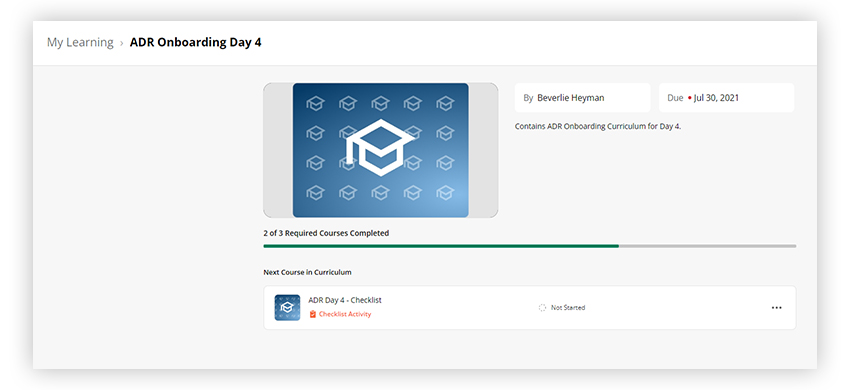
Brainshark ADR sales onboarding curriculum
Like asynchronous content, cohort content can be short or long-form and fit into previous categories described here. What distinguishes it is who it’s for and what the goal for that audience is. An onboarding program for a new batch of SDRs (sales development reps) or a certification course for product marketers are examples of cohort content.
Download the The Blueprint for Better Sales Onboarding to learn how to effectively onboard your sales reps to guarantee long-term results.
Unlike asynchronous content, cohort content usually has a given timeframe in which it should be consumed by the target audience. Offering content in a cohort model helps keep people on track — they have a group learning with them to keep them motivated.
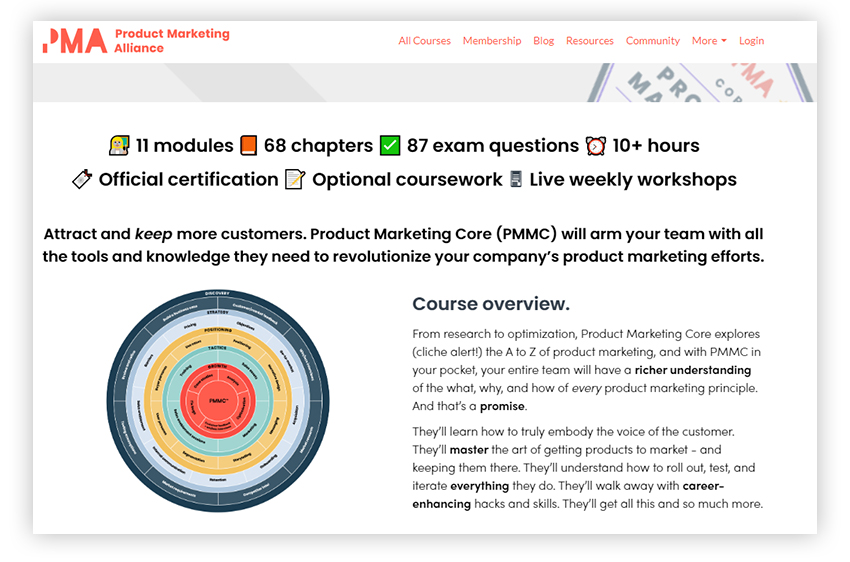
Cohort learning content can take the form of a curriculum, certification program, course, or series of microlearning videos with accompanying quizzes and written materials to reinforce knowledge.
Cohort sales collateral is content created for ICPs (ideal customer profiles) or personas, such as a webinar series targeted to CEOs in the tech industry or a graphic design 101 course offered to digital marketers.
Cohort content best practices:
- Spread longer, more in-depth content out over longer periods of time with shorter sessions. For example, turn an 8-hour workshop into an 8-week-long training with a 1-hour workshop each week.
- Each session should have an associated activity to reinforce the knowledge.
- If you can, offer a badge or certificate to motivate and reward learners.
Takeaways
- Less is more when it comes to your content catalog
- Avoid overwhelming the audience with too many options
- Create each piece of content with form, function, and the goal in mind
- Reduce, reuse, and recycle your content
- Use content data and analytics to inform your content strategy so your teams spend effort where it matters and create impactful pieces
